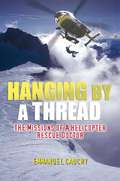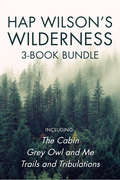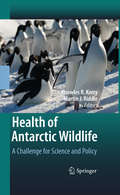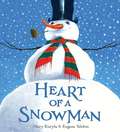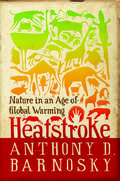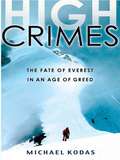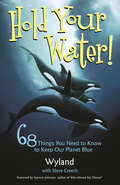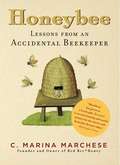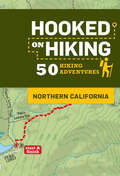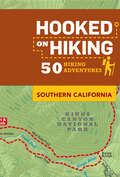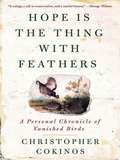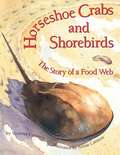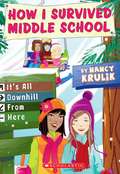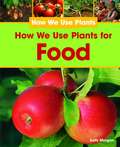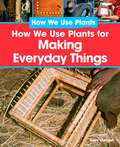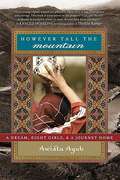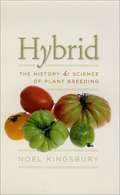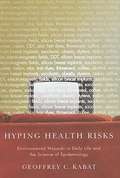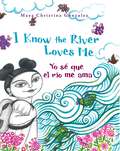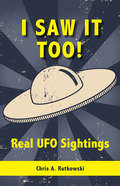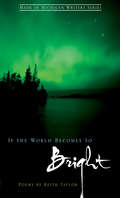- Table View
- List View
Hanging By A Thread: The Missions of a Helicopter Rescue Doctor
by Emmanuel CauchyOutdoor sports enthusiast and extreme doctor Emmanuel Cauchy reveals here for the first time the perilous rescues he’s performed in the world’s most terrifying and unforgiving mountain climates. Known around the world as the “vertical doctor,” Emmanuel Cauchy gives stunning and terrifying accounts of his days as a rescue doctor on Mont Blanc, which rises more than 11,000 feet in the Alps along the French-Italian border. From snowy mountain peaks and deep mountain crevasses to the small confines of a helicopter high above—Cauchy’s job takes him where most of us can only imagine.Using new scientific research pioneered on the mountainside in life-saving medical procedures, Cauchy’s dramatic mountain rescues will leave even the most seasoned reader, doctor, or outdoorsman astonished. Here are seventeen years spent in the air and on the ground in some of the world’s most unforgiving territory. His tales describe the extremes of both climate and human endurance and reverberate with the author’s unshakable love of life.This is an uplifting, extraordinary, and moving book from a great humanitarian stuntman who spent his time literally living life on the edge.
Hap Wilson's Wilderness 3-Book Bundle: The Cabin / Grey Owl and Me / Trails and Tribulations
by Hap WilsonNoted traveller and environmentalist Hap Wilson shares accounts of his lifelong involvement with wilderness living within the Canadian Shield. Wilson knows better than most how to live in the woods. As park ranger, canoe guide, outfitter, trail builder, and environmental activist, he learned from firsthand experience that nature can neither be beaten or tamed.This three-book bundle includes: The Cabin: A Search for Personal Sanctuary Noted environmentalist Hap Wilson takes us along a wilderness trail replete with snags and pitfalls, through mishaps, tears, and laughter. Grey Owl and Me: Stories From the Trail and Beyond Hap Wilson is back for another journey. Nurtured by the writings of Grey Owl, Wilson adopted a similar lifestyle to the 1930s conservationist but with his own twists and turns. Wilson recounts the early days of winter camping, takes readers to some of his favourite places, and shares intimate secrets of wilderness living. Trails and Tribulations:Confessions of a Wilderness Pathfinder Noted northern traveller Hap Wilson shares accounts of his lifelong involvement with wilderness living within the Canadian Shield. A park ranger, canoe guide, and environmental activist, Wilson takes the reader on a journey through natural settings ranging from austere to mysterious and breathtaking.
Health of Antarctic Wildlife
by Martin Riddle Knowles R. KerryThis book provides a broad assessment of the health of Antarctica's and seals. It is set against the background of available scientific and environmental information and the political and administrative processes in place. 17 chapters are presented in two parts: "Wildlife Disease" consists of reviews, case studies and health assessments. "External Factors" covers the environmental, administrative and legal aspects. The term health is used in its widest sense to encompass the normal state and those factors which detract from it including both infectious and non-infectious causes. A must for veterinary and biological scientists, policy makers and administrators whose job it is to protect Antarctica's wildlife against the introduction or spread of diseases by human activities.
Heart of a Snowman
by Eugene Yelchin Mary KurylaEvery Christmas Eve, a boy named Owen builds the very best snowman he can, only to see it melt away on Christmas Day. There must be a way to make it last, he thinks. So begins an adventure that leads Owen to a magical place where curious animals study his snowman piece by piece in an attempt to remake a perfect snowman. But in the end, it is Owen who supplies the one thing they need the most. Have they finally found the secret to making a snowman that will last forever?
Heatstroke: Nature in an Age of Global Warming
by Anthony D. BarnoskyIn 2006, one of the hottest years on record, a "pizzly" was discovered near the top of the world. Half polar bear, half grizzly, this never-before-seen animal might be dismissed as a fluke of nature. Anthony Barnosky instead sees it as a harbinger of things to come. In Heatstroke, the renowned paleoecologist shows how global warming is fundamentally changing the natural world and its creatures. While melting ice may have helped produce the pizzly, climate change is more likely to wipe out species than to create them. Plants and animals that have followed the same rhythms for millennia are suddenly being confronted with a world they're unprepared for--and adaptation usually isn't an option. This is not the first time climate change has dramatically transformed Earth. Barnosky draws connections between the coming centuries and the end of the last ice age, when mass extinctions swept the planet. The differences now are that climate change is faster and hotter than past changes, and for the first time humanity is driving it. Which means this time we can work to stop it. No one knows exactly what nature will come to look like in this new age of global warming. But Heatstroke gives us a haunting portrait of what we stand to lose and the vitality of what can be saved.
High Crimes: The Fate of Everest in an Age of Greed
by Michael KodasHigh Crimes is journalist Michael Kodas's gripping account of life on top of the world--where man is every bit as deadly as Mother Nature. In the years following the publication of Into Thin Air, much has changed on Mount Everest. Among all the books documenting the glorious adventures in mountains around the world, none details how the recent infusion of wealthy climbers is drawing crime to the highest place on the planet. The change is caused both by a tremendous boom in traffic, and a new class of parasitic and predatory adventurer. It's likely that Jon Krakauer would not recognize the camps that he visited on Mount Everest almost a decade ago. This book takes readers on a harrowing tour of the criminal underworld on the slopes of the world's most majestic mountain. High Crimes describes two major expeditions: the tragic story of Nils Antezana, a climber who died on Everest after he was abandoned by his guide; as well as the author's own story of his participation in the Connecticut Everest Expedition, guided by George Dijmarescu and his wife and climbing partner, Lhakpa Sherpa. Dijmarescu, who at first seemed well-intentioned and charming, turned increasingly hostile to his own wife, as well as to the author and the other women on the team. By the end of the expedition, the three women could not travel unaccompanied in base camp due to the threat of violence. Those that tried to stand against the violence and theft found that the worst of the intimidation had followed them home to Connecticut. Beatings, thefts, drugs, prostitution, coercion, threats, and abandonment on the highest slopes of Everest and other mountains have become the rule rather than the exception. Kodas describes many such experiences, and explores the larger issues these stories raise with thriller-like intensity.
Hold Your Water: 68 Things You Need to Know to Keep Our Planet Blue
by Wyland Steve CreechHold Your Water offers insight into the water and world around us. Taking a conversational approach to conservation, it dives into simple ways that even little old you can make a difference--all with a witty, and at times whimsical, slant on the world in which we live. The Wyland Foundation is widely lauded by politicians and scientists alike for its practical insight and positive impact on our planet. Former Vice President Al Gore praised the group, saying, "Your organization makes an invaluable contribution to the effort to promote environmental awareness."Hold Your Water is the latest in the organization's legacy of arming everyday people with straight-ahead insight and simple tips for keeping our planet blue. Written by two members of Wyland's staff, the book provides countless fascinating facts about our planet. For instance, did you realize that while two-thirds of the earth's surface is covered by water, only 3 percent of that water is safe to drink? And of that 3 percent, nearly two-thirds is locked up in polar ice caps?The book offers easy ways for people to help preserve water and other related precious resources. Divided into more than 30 sections, this compendium illustrates how everyday activities such as car washing, showering, fertilizing--even 'pet poop' cleanup--can negatively impact the environment. It then delivers more than 100 tips and tidbits that will help you protect your planet.Whether you are one of the nearly three-quarters of Americans who consider themselves environmentalists, or you just want to know more about the world in which you live, Hold Your Water is a book worth holding on to.
Holocene Palaeoenvironmental History of the Central Sahara: Palaeoecology of Africa Vol. 29, An International Yearbook of Landscape Evolution and Palaeoenvironments (Palaeoecology of Africa)
by Jürgen Runge Roland BaumhauerThe environmental setting within the Central Sahara was subject to considerable changes during Late Quaternary, mainly driven by major global climate variations, although human impact increased constantly since Early Holocene.Such global events can be reconstructed with the help of reliefs, sediments and palaeosoils and their specific morphological
Honeybee: Lessons from an Accidental Beekeeper
by C. Marina MarcheseNow in paperback, Marina Marchese's inspirational and practical story of learning to raise honeybees and creating a life she loves "[An] engaging, delightfully informative work?" ?Publishers Weekly "Marchese has given us a lovely gift. Honeybee is an entertaining and useful primer for the novice and honeybee devotee alike." ?Washington Times "Surpassing the predictable "how I changed careers" memoir of finding the good life, Marchese's informative guide is packed with facts about everything from pollination to harvesting, life cycles to historical lore, nutritional benefits to gourmet flavor combinations, medical applications to unusual varieties." ?BooklistIn 1999, Marina Marchese fell in love with bees during a tour of a neighbor's honeybee hives. She quit her job, acquired her own bees, built her own hives, harvested honey, earned a certificate in apitherapy, studied wine tasting in order to transfer those skills to honey tasting, and eventually opened her own honey business. Today, Red Bee® Honey sells artisanal honey and honey-related products to shops and restaurants all over the country. More than an inspiring story of one woman's transformative relationship with honeybees (some of nature's most fascinating creatures), Honeybee is also bursting with information about all aspects of bees, beekeeping, and honey?including life inside the hive; the role of the queen, workers, and drones; pollination and its importance to sustaining all life; the culinary pleasures of honey; hiving and keeping honeybees; the ancient practice of apitherapy, or healing with honey, pollen, and bee venom; and much more. Recipes for food and personal care products appear throughout. Also included is an excellent, one-of-a-kind appendix that lists 75 different honey varietals, with information on provenance, tasting notes, and food-and-wine pairings.
Hooked on Hiking: 50 Hiking Adventures
by Ann Marie BrownExperience the grandeur and beauty of Northern California’s nature preserves and national parks with this informative hiking guide.Take a hike and discover Northern California’s breathtaking parks, forests, and more. With detailed topographic maps and instructions for fifty easy to moderate hikes, Hooked on Hiking: Northern California is your ultimate guide to exploring the rich and diverse natural landscapes of this breathtaking region.Hikes include:YosemiteMuir WoodsRedwoods National ParkNapa ValleyAnd much more!
Hooked on Hiking: 50 Hiking Adventures
by Ann Marie Brown Tim Lohnes Bart WrightEach of these decks is packed with 50 hiking adventures and comes equipped with a handy clip-on carabiner for bringing cards along wherever the trail leads.Take a hike through Southern California's beautiful parks, forests, and more.Hikes include: Joshua Tree Death Valley Channel Islands National Park Kings Canyon
Hope Is the Thing With Feathers
by Christopher CokinosWeaves together natural history, biology, sociology, and personal narrative to tell the story of the lives, habitats, and deaths of six extinct bird species. This book is, in part, an effort to make certain that we never again forget extinct species nor the others of which Cokinos write. As Cokinos traveled to libraries and natural history museums, he learned of other vanished birds: the Ivory-billed Woodpecker, the Heath Hen, the Passenger Pigeon, the Labrador Duck and the Great Auk. He was moved to write about them, and the result is this impressive book about the ¿ghost species¿ of the North American continent. The cover has the look of stained and mottled pages from a naturalist¿s notebook. Illustrations.
Hope Is the Thing With Feathers
by Christopher CokinosA prizewinning poet and nature writer weaves together natural history, biology, sociology, and personal narrative to tell the story of the lives, habitats, and deaths of six extinct bird species.
Horseshoe Crabs And Shorebirds: The Story Of A Foodweb
by Victoria Crenson Annie CannonEach spring, hundreds of thousands of horseshoe crabs crawl from the bottom of Delaware Bay to lay billions of pearly green eggs on the beaches. Their salty eggs provide a feast for scavenging coastal animals, but billions more are eaten by the flocks of shorebirds that stop to rest and feed each spring after flying north from their homes in South America. In recent years the horseshoe crab population has dwindled. In turn, the number of shorebirds that fly north each year has grown smaller. Illuminated with warm, detailed watercolors, Horseshoe Crabs and Shorebirds demonstrates the delicate relationship between these animals and is an excellent resource for ecology lessons, as well as a dramatic storybook for sharing.
How I Survived Middle School #8: It's All Downhill From Here
by Nancy KrulikBestselling author Nancy Krulik delves into the mind of a twelve-year-old trying to survive middle school.<P><P> It's wintertime at Joyce Kilmer Middle School, and everyone is thrilled when school is closed because of a huge snowstorm. Everyone except Jenny, that is! Addie's mom has to work, so Addie's spending the day at Jenny's house. Jenny's stuck hanging out with her former BFF while her friends all go sledding. Thinking about the upcoming school-sponsored ski trip helps get Jenny through the day, but will Addie ruin that for her, too?
How We Use Plants for Food
by Sally MorganPlants are used to make so many foods that we eat! This title engages readers with easy do-it-yourself experiments as it explains the many fascinating ways plants can be made into food; from cereal, fruits and vegetables, to sugar and oils. Different parts of the plant are used to make these foods; and freshness and preservation are equally important.
How We Use Plants for Making Everyday Things
by Sally MorganMany of the things we use each day are made from plants. Readers may not realize that the clothes they wear or the rubber tires on their bicycle are made from plants. This book covers plant-based items from fabrics to paper. Students will have the opportunity to participate in the process as they learn how to make their own paper!
How We Use Plants for Medicine and Health
by Sally MorganPeople use plants for a variety of medicinal and health purposes from making herbal remedies and pain killers, to products for skin care and healthy teeth to fighting diseases like cancer. Readers will also have the chance to make their own plant remedy.
However Tall the Mountain: A Dream, Eight Girls, and a Journey Home
by Awista Ayub"The young Afghan women in However Tall The Mountain are pioneers. Their story is one of resilience and courage. This book is a testament to the power of hope and the will to dream in a country where so many dreams have been cut short." --Khaled Hosseini, bestselling author of The Kite Runner and A Thousand Splendid Suns. "Awista Ayub has movingly captured the indomitable spirit of Afghan women in this chronicle of brave girls who risked persecution and worse to pursue the dreams of ordinary childhood. In doing what they love most in life - playing soccer - the girls become emblems of the fight for equality and human rights under the Taliban. Their story reminds us that there is always hope and possibility for a brighter future - even in the wreckage left by war and conflict. " --Secretary of State Hillary Rodham Clinton A ball can start a revolution. Born in Kabul, Awista Ayub escaped with her family to Connecticut in 1981, when she was two years old, but her connection to her heritage remained strong. An athlete her whole life, she was inspired to start the Afghan Youth Sports Exchange after September 11, 2001, as a way of uniting girls of Afghanistan and giving them hope for their future. She chose soccer because little more than a ball and a field is needed to play; however, the courage it would take for girls in Afghanistan to do this would have to be tremendous--and the social change it could bring about by making a loud and clear statement for Afghan women was enough to convince Awista that it was possible, and even necessary. Under Taliban rule, girls in Afghanistan couldn't play outside of their homes, let alone participate in a sport on a team. So, Awista brought eight girls from Afghanistan to the United States for a soccer clinic, in the hope of not only teaching them the sport, but also instilling confidence and a belief in their self-worth. They returned to Afghanistan and spread their interest in playing soccer; when Awista traveled there to host another clinic, hundreds of girls turned out to participate--and the numbers of players and teams keep growing. What began with eight young women has now exploded into something of a phenomenon. Fifteen teams now compete in the Afghanistan Football Federation, with hundreds of girls participating. Against all odds and fear, these girls decided to come together and play a sport that has reintroduced the very traits that decades of war had cruelly stripped away from them--confidence and self-worth. In However Tall the Mountain, Awista tells both her own story and the deeply moving stories of the eight original girls, describing their daily lives back in Afghanistan, and how they found strength in each other, in teamwork, and in themselves--taking impossible risks to obtain freedoms we take for granted. This is a story about hope, about what home is, and in the end, about determination. As the Afghan proverb says, However tall the mountain, there's always a road.
Hybrid: The History and Science of Plant Breeding
by Noel KingsburyDisheartened by the shrink-wrapped, Styrofoam-packed state of contemporary supermarket fruits and vegetables, many shoppers hark back to a more innocent time, to visions of succulent red tomatoes plucked straight from the vine, gleaming orange carrots pulled from loamy brown soil, swirling heads of green lettuce basking in the sun. With Hybrid, Noel Kingsbury reveals that even those imaginary perfect foods are themselves far from anything that could properly be called natural; rather, they represent the end of a millennia-long history of selective breeding and hybridization. Starting his story at the birth of agriculture, Kingsbury traces the history of human attempts to make plants more reliable, productive, and nutritious--a story that owes as much to accident and error as to innovation and experiment. Drawing on historical and scientific accounts, as well as a rich trove of anecdotes, Kingsbury shows how scientists, amateur breeders, and countless anonymous farmers and gardeners slowly caused the evolutionary pressures of nature to be supplanted by those of human needs--and thus led us from sparse wild grasses to succulent corn cobs, and from mealy, white wild carrots to the juicy vegetables we enjoy today. At the same time, Kingsbury reminds us that contemporary controversies over the Green Revolution and genetically modified crops are not new; plant breeding has always had a political dimension. A powerful reminder of the complicated and ever-evolving relationship between humans and the natural world, Hybrid will give readers a thoughtful new perspective on--and a renewed appreciation of--the cereal crops, vegetables, fruits, and flowers that are central to our way of life.
Hyping Health Risks: Environmental Hazards in Daily Life and the Science of Epidemiology
by Geoffrey C. KabatAccording to author and epidemiologist Geoffrey C. Kabat, this hyping of low-level environmental hazards leads to needless anxiety and confusion on the part of the public as to which exposures have important effects on health.
I Know the River Loves Me / Yo sé que el río me ama: Yo Sé Que El Río Me Ama
by Maya GonzalezBilingual English/Spanish. Listen... Can you hear the river calling you? Rushing and bubbling, splashing or still, the river has so much to teach us.Whenever Maya visits the river, the river jumps up to greet her. It cools her down when the summer sun is too hot, and holds her up when she dives in. It keeps her company in the quiet of winter. The river takes care of Maya and Maya takes care of the river. In this gentle story of love and respect for nature, Maya Christina Gonzalez combines her award-winning talents as an artist and storyteller. Young readers will be inspired by the joy and wonder of being outdoors, and learn powerful lessons about their environment and themselves.
I Saw It Too!: Real UFO Sightings
by Chris A. RutkowskiAlthough many adults believe they have had encounters with strange creatures from alien spaceships, not everyone has actually reported their experiences to official investigators. But if you’re a young person it’s even less likely that people will believe you and more likely that your story will never be officially recorded. After all, who would believe a kid? I Saw It Too! is the first collection of stories told by children, documenting what they saw and when they saw it. These accounts are real cases of UFOs they’ve seen or alien creatures they’ve encountered that were reported to government or military officials, UFO investigators, and journalists. Inside you will find eighteen of these strange, fascinating, and believable tales recounted by young people from around the world with story illustrations by Stacey Archer with Lonigan Gilbert. The truth is really out there, and renowned ufologist Chris Rutkowski has tracked it down!
I'm Dreaming of a Green Christmas: Gifts, Decorations, and Recipes that Use Less and Mean More
by Anna GettyThe author and green living expert shares savvy tips on how to celebrate Christmas in ways that are eco-friendly and cost-conscious.Anna Getty—a chef, writer, mother, and organic living expert—helps families reduce their carbon footprint and save money while enjoying the festive traditions of Christmas. Anna advises how to best choose a tree (real or fake?), mitigate the negative effects of holiday travel, recycle post-holiday, and more. Anna also shares favorite holiday recipes for organic appetizers and homemade craft ideas such as pinecone wreaths and recycled sweater pillows. With inspiring photographs, extensive resources, and advice from the “Lazy Environmentalist” Josh Dorfman, Seventh Generation’s Jeffrey Hollender, and other leading eco-experts, families might just find that these tips help them stay green all year long—the perfect New Year’s resolution!
If the World Becomes So Bright: If The World Becomes So Bright
by Keith TaylorA lyrical and accessible collection that explores both the landscape of Michigan and the inner life of one person who lives there.
